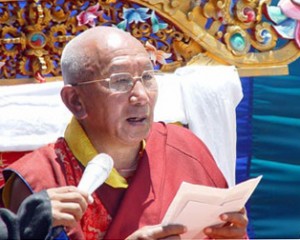Harmony of nature from a Buddhist point of view
by Ven. Ngawang Tenzing Zangpo Rinpoche
Main lama of Tengboche monastery in Khumbu - Mt. Everest Region – Nepal
According to Buddhist texts, the world as we know it sprang from the the life force of „Zambu-tikya“, the wish fulfilling tree.
As per the Buddhist teachings by Buddha Shakyamuni (563 – 483 BC), our bodies are composed of the elements earth, water, fire, wind and space.
The same elements also form the trees, and like them, people live through the dynamic balance of these elements.
And like people, trees are also concerned by natural desasters like droughts and inundations.
For Buddhists, trees are very important – on a spiritual and material level. During Buddha Shakyamunis birth in Lumbini in southern Nepal,
his mother clutched a branch of the „Bodhi“ tree (Ficus regligiosa), and it was sitting under a „Bodhi“ tree in Bodhgaya (Bihar, India),
that Buddha Shakyamuni recognized the true nature of reality and reached enlightenment. Trees offered shelter to the meditating and
supported all Buddhas in their search for enlightenment.
Buddhists learn that trees are inhabited by numerous gods and spirits who influence the weather, the harvest and the wellbeing of all
people living in their environment. As long as people live in harmony with their environment, the local gods and spirits, peace and
benevolence will prevail. When we cut trees, dig the earth and pollute the mountains, the gods and spirits are disturbed which leads to
natural desasters and disease.

Plenty of examples show how the cutting of trees, the production of toxic chemicals and unnecessary waste lead to
negative consequences including new and untreatable diseases, natural desasters and mental/spiritual restlessness.
If these activities cannot be avoided, we have to reduce their harmful impact. One way of doing so is to beg the gods and spirits
through special ceremonies to minimize the negative consequences. One practice to do so is „the healing of the earth“
by burying „Sachu –Bumpas“ – (Tibetan), rotund vases with consecrated contents. Two years ago, during a drought throughout Nepal,
we passed on 1300 of such vases.
In my own monastery Tengboche in Nepal, we try to support environment protection and to reduce pollution and waste.
In times of increased tourism, rapid development and demands towards the environment, we try to foster an awareness
for the relation between spirituality and nature. Planting trees also reduces harmful consequences for the environment and acts
life prolonging. The ecological center “Sacred Land“ in Tengboche provides us with incentive and the means for sustainability and
expansion of the past efforts.


Practicing Buddhists and modern conservationists have more in common than is usually assumed.
In the Himalayas, traditional cultures and Buddhism, Bön, Hinduism and Jainism have been most effective in the
conservation of the environment even before protected areas have been created. The logical basis of the conservation
is not necessarily the same, but the result often is. As an example: conservationists often caution against the cutting
of trees since it will lead to landslides, inundations and – as I have been told – to global warming. Buddhists also caution
against these activities.
They say gods and spirits will be displeased which has negative consequences for us.
Our world is not the same as it was yesterday: the population has grown, we have new and increased needs and therefore more
effort in supporting a healthy, natural environment - which in the end is ours - is necessary. In the immediate vicinity of
Tengboche, we plant trees, cultivate medical plants and increase awareness so as to reduce pollution and waste, and we support
nature’s conservation. Please try to do the same in your home country, wherever that may be.

Ngawang Tenzin Jangpo
Tengboche Rinpoche Principal lama of Tengboche monastery Khumbu – Mt. Everest region – Nepal, Himalayas
In 1935, on the same day as the Dalai Lama, Tengboche Rinpoche was born in Namche Bazaar in Khumbu valley – Mt. Everest region – Nepal, Himalayas. As a child, he insisted that he had a house and several posessions in Tengboche. During a test, Rinpoche chose posessions which belonged to the principal lama of the monastery who had passed away and he also recognized his former acquaintances. Consequently, Tengboche Rinpoche is an acknowledged „Tulku“ (reincarnation). Rinpoche spent 10 years studying Buddhist philosophy in Tibet and in 1956, he took over the function as principal lama of Tengboche. He is responsible for the ceremonies, the daily procedures in the monastery and the instruction and education of his monks.
Tengboche Rinpoche starts his day very early doing wishes and meditation. After that, he is open for everybody and a constant flow of people, lamas, sherpas and tourists comes to his door. He names children, conducts ceremonies for the deceased, blesses marriages and houses. He is familiar with the art of Sowa Rigpa transmission, the Buddhist science of healing. All day long, he makes wishes for the wellbeing of all creatures, helps others and for many, he is the last refuge. Rinpoche spends his evenings with long hours of meditation.
Rinpoche is responsible for all aspects of the sherpas and he makes propaganda for active environmental protection. He treats all with the same amount of respect. The former king of Nepal, high government officials and beggars - all come to ask for his advise. His life is a constant dedication to others.








